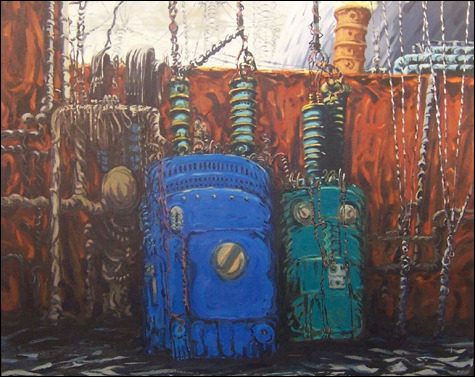
"SUBSTATION" By Dennis Pinette, oil on canvas, 63 x 69 inches, 1988. |
| "The Discerning Eye of Rose Marie Frick" through April 26 | at Aucocisco Gallery, 613 Congress St, Portland | 207.775.2222 |
In the early ’90s the sleepy little Downeast town of Belfast had its 15 minutes of fame. Long known as a center of chicken processing (motto: "Where the chicken meets the sea"), its low housing costs and beautiful harbor attracted artists, and the artists attracted galleries. It gained national attention as one of the best little art towns in the country. Rose Marie Frick’s polished gallery of modernist art was central to that reputation. For a number of years it was a prominent member of the tiny group of serious contemporary galleries in Maine.As always happens, the real-estate market follows the artists, prices went up, and the little burst of interest in Belfast faltered. The galleries, including Frick’s, closed, and Belfast became a credit-card center, where debtors are plucked instead of chickens. Frick has, in the ensuing years, been active as an art consultant and curator.
"The Discerning Eye of Rose Marie Frick" at Aucocisco gathers a group of a dozen artists who showed at the Frick gallery at one time or another. The solo show of recent paintings by Elizabeth Cashin McMillen, also at Aucocisco, isn’t part of the Frick show, but she showed there as well.
It’s a bit of a reunion, but not a retrospective. The work of the dozen artists in the group show covers the period from Dennis Pinette, whose painting “Substation” dates from 1988 and was shown in the heyday of the Frick gallery, to the very recent work of Noriko Sakanishi and Don Voisine, but most were executed within the last few years. A little arithmetic shows that all these artists have been around a while. This is not a show of beginners. All are in their 40s or older.
The art world tends to bestow notice on the young, looking for the crest of the next wave of art fashion. Frick has, in her choices, worked against the atmosphere that treats art as if it were a consumer commodity, to be acquired as soon as the newest thing makes itself known. She proves there is value in watching the work of a dedicated artist over the long haul to see how ideas develop. Maturity, whether personal or artistic, is not usually something that happens overnight. It evolves over time.
The current orthodoxy requires art that is riddled with post-Warholian irony and is laced with academic requirements for social relevance. That’s what has become the 21st-century de facto version of the dominant 19th-century French Academy of Fine Arts, with Jeff Koons as its latter-day Bouguereau.
The artists Frick has chosen are, and have been, pursuing their work well outside that establishment. Their mostly abstract ideas lie within the broad scope of modernism as it grew out of the work of Cezanne, Matisse, Mondrian, and, eventually, Pollock. Abstract art is, as Bette Davis said of old age, not for sissies. To make an abstract work of art is to skate along the knife-edge of meaning. Lean too far off-balance and your work devolves into mere design
This is, I think, the way to approach this show. These are people who were working professionals when they were first invited to show by Frick years ago and are working professionals now, each with their own artistic problems to solve and questions to ask. They are quite different, one from another, but they share a faith in the transformative quality of art made on its own terms. Those terms don’t just happen. They are developed and discovered, worked and reworked, sometimes over many years.
Since we can’t all follow this many artists as their careers progress and watch how, or whether, their work develops, we must leave that task for Frick. Somebody has to do it.
Ken Greenleaf can be reached at ken.greenleaf@gmail.com.